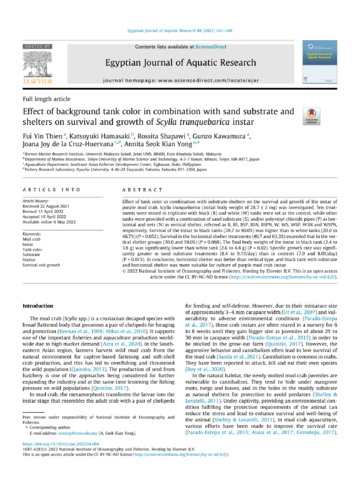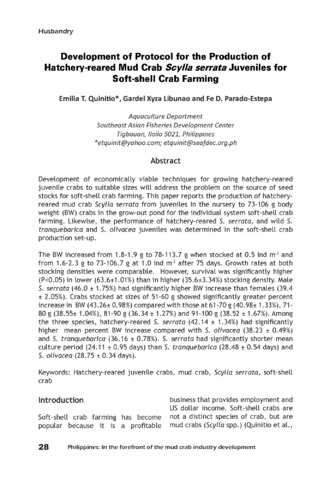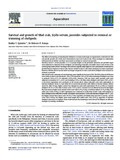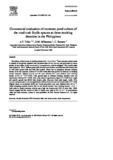Effect of background tank color in combination with sand substrate and shelters on survival and growth of Scylla tranquebarica instar
Share
Abstract
Effect of tank color in combination with substrate-shelters on the survival and growth of the instar of purple mud crab, Scylla tranquebarica (initial body weight of 28.7 ± 2 mg) was investigated. Ten treatments were tested in triplicate with black (B) and white (W) tanks were set as the control, while other tanks were provided with a combination of sand substrate (S), and/or polyvinyl chloride pipes (P) as horizontal and nets (N) as vertical shelter, referred as B, BS, BSP, BSN, BSPN, W, WS, WSP, WSN and WSPN, respectively. Survival of the instar in black tanks (26.7 to 60.0%) was higher than in white tanks (20.0 to 46.7%) (P = 0.052). Survival in the horizontal shelter treatments (46.7 and 63.3%) exceeded that in the vertical shelter groups (30.0 and 50.0%) (P = 0.068). The final body weight of the instar in black tank (2.4 to 3.8 g) was significantly lower than white tank (2.6 to 4.8 g) (P = 0.02). Specific growth rate was significantly greater in sand substrate treatments (8.4 to 9.1%/day) than in controls (7.9 and 8.0%/day) (P = 0.015). In conclusion, horizontal shelter was better than vertical type, and black tank with substrate and horizontal shelter was more suitable for culture of purple mud crab instar.
Suggested Citation
Thien, F. Y., Hamasaki, K., Shapawi, R., Kawamura, G., Huervana, J. J., & Yong, A. S. K. (2022). Effect of background tank color in combination with sand substrate and shelters on survival and growth of Scylla tranquebarica instar. The Egyptian Journal of Aquatic Research , 48(3), 241-246. https://doi.org/10.1016/j.ejar.2022.04.004
Subject
Taxonomic term
Collections
- AQD Journal Articles [1249]
Related items
Showing items related by title, author, creator and subject.
-
Development of protocol for the production of hatchery-reared mud crab Scylla serrata juveniles for soft-shell crab farming
Quinitio, Emilia T.; Libunao, Gardel Xyza; Parado-Estepa, Fe D. (Aquaculture Department, Southeast Asian Fisheries Development Center, 2017)Development of economically viable techniques for growing hatchery-reared juvenile crabs to suitable sizes will address the problem on the source of seed stocks for soft-shell crab farming. This paper reports the production ... -
Survival and growth of mud crab, Scylla serrata, juveniles subjected to removal or trimming of chelipeds
Quinitio, Emilia T.; Estepa, Fe Dolores P. (Elsevier, 2011)The effects of removing or trimming the chelipeds at various molt stages on regeneration, molt interval (MI) and specific growth rate (SGR) were determined in mud crab Scylla serrata. These strategies in combination with ... -
Commercial evaluation of monosex pond culture of the mud crab Scylla species at three stocking densities in the Philippines.
Triño, Avelino T.; Millamena, Oseni M.; Keenan, C. (Elsevier, 1999)The effects of three levels of stocking density (0.5, 1.5 or 3.0 m−2) and monosex culture (male or female) on the growth, apparent feed conversion ratio (FCR), survival, and production of mixed species of mud ...




